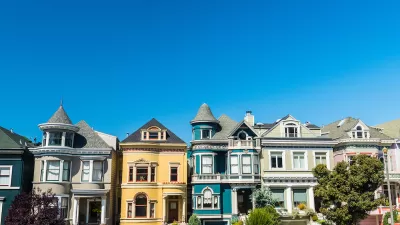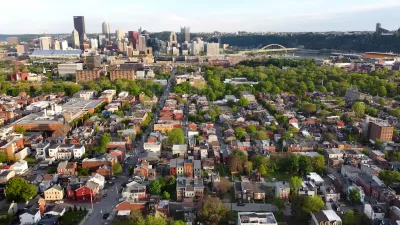Fast Company blogger Michael Cannell says the economic crisis stands to make big winners out of the new urbanists.
"The downturn has accomplished what a generation of designers and planners could not: it has turned back the tide of suburban sprawl. In the wake of the foreclosure crisis many new subdivisions are left half built and more established suburbs face abandonment. Cul-de-sac neighborhoods once filled with the sound of backyard barbecues and playing children are falling silent. Communities like Elk Grove, Calif., and Windy Ridge, N.C., are slowly turning into ghost towns with overgrown lawns, vacant strip malls and squatters camping in empty homes. In Cleveland alone, one of every 13 houses is now vacant, according to an article published Sunday in The New York Times magazine.
The demand for suburban homes may never recover, given the long-term prospects of energy costs for commuting and heating, and the prohibitive inefficiencies of low-density construction. The whole suburban idea was founded on disposable spending and the promise of cheap gas. Without them, it may wither. A study by the Metropolitan Institute at Virginia Tech predicts that by 2025 there will be as many as 22 million unwanted large-lot homes in suburban areas."
Thanks to Neil Takemoto
FULL STORY: Suburbia R.I.P.

Manufactured Crisis: Losing the Nation’s Largest Source of Unsubsidized Affordable Housing
Manufactured housing communities have long been an affordable housing option for millions of people living in the U.S., but that affordability is disappearing rapidly. How did we get here?

Americans May Be Stuck — But Why?
Americans are moving a lot less than they once did, and that is a problem. While Yoni Applebaum, in his highly-publicized article Stuck, gets the reasons badly wrong, it's still important to ask: why are we moving so much less than before?

Using Old Oil and Gas Wells for Green Energy Storage
Penn State researchers have found that repurposing abandoned oil and gas wells for geothermal-assisted compressed-air energy storage can boost efficiency, reduce environmental risks, and support clean energy and job transitions.

Greening Oakland’s School Grounds
With help from community partners like the Trust for Public Land, Oakland Unified School District is turning barren, asphalt-covered schoolyards into vibrant, green spaces that support outdoor learning, play, and student well-being.

California Governor Suspends CEQA Reviews for Utilities in Fire Areas
Utility restoration efforts in areas affected by the January wildfires in Los Angeles will be exempt from environmental regulations to speed up the rebuilding of essential infrastructure.

Native American Communities Prepare to Lead on Environmental Stewardship
In the face of federal threats to public lands and conservation efforts, indigenous groups continue to model nature-centered conservation efforts.
Urban Design for Planners 1: Software Tools
This six-course series explores essential urban design concepts using open source software and equips planners with the tools they need to participate fully in the urban design process.
Planning for Universal Design
Learn the tools for implementing Universal Design in planning regulations.
Heyer Gruel & Associates PA
City of Moreno Valley
Institute for Housing and Urban Development Studies (IHS)
City of Grandview
Harvard GSD Executive Education
Salt Lake City
NYU Wagner Graduate School of Public Service
City of Cambridge, Maryland





























